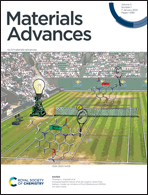Leaf-like copper oxide mesocrystals by collagen-assisted biomineralization show attractive biofunctional and electrochemical properties†
Abstract
The development of high-performance biocompatible batteries is pivotal in personalized health-care devices such as pacemakers and neuro-stimulators. We have for the first time developed a one-pot collagen-assisted biomineralization strategy to create hierarchical CuO nanostructures. Recombinant collagen has been demonstrated as an excellent biotemplate to delicately tune the morphologies of copper oxide mesocrystals. The initial formation of Cu(OH)2 nanoneedles gradually turned into leaf-like CuO nanostructures with branched edges and a compact middle during the biomineralization process. The as-prepared leaf-like CuO mesocrystals exhibited an attractive electrochemical performance, and may have great potential as a promising anode material for lithium-ion batteries. Notably, collagen also acts as an excellent functional agent to endow the CuO nanomaterials with high biocompatibility and bioactivity. The environmentally friendly method assisted by collagen provides novel opportunities for the construction of advanced CuO nanomaterials that have a well-controlled morphology, function and electrochemical performance, and which may have promising applications in implantable health-care electronics.



 Please wait while we load your content...
Please wait while we load your content...